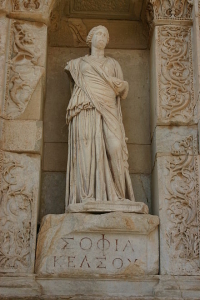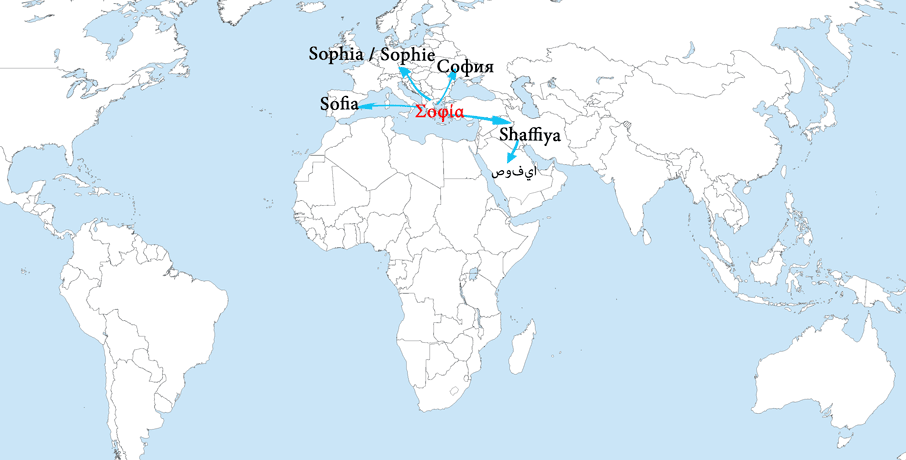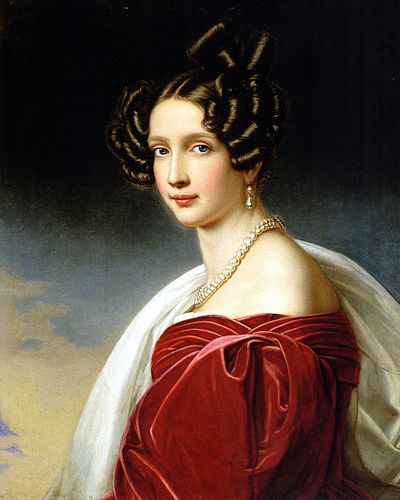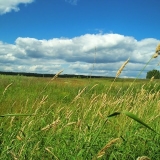The name Sophia has now become one of the most popular baby names around the globe. You can find it amongst the top favourites in Europe, the Americas and even Asia. It is widely used by people from all cultures and ways of life.
The Origins
Few people know where it came from and how it spread from continent to continent, generation to generation and even between different religions.
Sophia is actually one of the oldest names in the world, still in use today.
It originated in Ancient Greece and it meant “wisdom“, as in the word “philoSophia”, love for wisdom. The idea was often allegorically represented as a beautiful, young woman, since the word itself is feminine.

Allegorical representation of wisdom
In Pagan times, Sophia / Σοφία was associated with the goddess Athena, who stood for wisdom, knowledge, war and owls – used as symbols for the deity and all its attributes. This is why even today, we find owls engraved on college logos and academic journals.
During the Late Antiquity, that is, sometime between the 3rd and the 6th century A.D. the idea of Sophia as wisdom was adopted by the new Christian and Gnostic sects and transformed into a symbol for divine wisdom and the purity of the soul. All earlier associations with the pagan goddess were forgotten as the philosophical term became a household name.
It retains its ancient meaning of wisdom to this day.
Christian Greek women started being named Sophia, with some of them even becoming saints or later queens of the Byzantine Empire. The first non-Greek people who started using the name Sophia were those who came into direct contact to Byzantium and Eastern Orthodox Christianity.
The Latinized people of the Balkans became Christians as early as the 5th century A.D. and replaced their traditional pagan names with new Christian ones.
The First Expansion
From Byzantine Greece, the name was adopted by the newly christened Slavic nations, the Bulgarians, the Moravians and the Kievan Russians in the 9th century A.D. as София, Sofyia, Sofija, Zofia, Žofia and Žofie.
Although quite early on, Rome became a Christian centre, it followed the Latin tradition, so all the other people who converted later, the Franks, Germans, Saxons, Visigoths, Baltic and Scandinavians, took the names of Latin saints, instead of Greek ones. They did not use the name Sophia until much later.
However, further in the East, when the Arabs and Islam came into contact with Greek philosophy and Christianity, they borrowed the name Sophia, added a new meaning as “the chosen one“, and spread it in Persia and the Near East as صوفيا, Shaffiyya, Safia or Safiye.
 The Second Expansion
The Second Expansion
In Western and Northern Europe, the Renaissance of the 15th century and the Protestant Reformation of the 16th century brought about a shift in mysticism and names.
Renascent scholars started studying Greek again and rediscovered the concept of Sophia, while the Protestants returned to the Ancient Christian roots and in order to mark that, they started adopting biblical and ancient names in their original form, although quite timidly. But even if Sophia started being used as a name sporadically, it did not become common or popular.
After the discovery of the Americas and the colonization of Asia and Africa, Protestant and Catholic missionaries were sent to christen whomever they could. Thus the name Sophia or often its English equivalent of Sophie reached America, India and the Philippines from the 16th century, Africa from the 17th century and Australia from the 18th century. Since it wasn’t yet in fashion in Western Europe, it wasn’t very much used in the colonies either.

In Eastern Europe and Central Asia the situation was a bit different, since Sophia was a popular name amongst Orthodox Christians. It was popular since the Middle Ages and came back in fashion in waves.
When Tsarist Russia started expanding East in Siberia in the 16th century it brought with it Russian names, many of Greek origin, including Sophia. This is why you can find Kazakhs, Turkmen, Yakuts and even Mongolians with this name.
However, not until the 19th century do we see a real appreciation and use of the name Sophia and Sophie.
The Legacy
During its long history and use, the name Sophia has also produced a few descendants, which have also come to travel far and wide. They were once simple variants of it, but are now used and recognized as full standing names.
One form that has come to be considered separate is Sophie or Sofie, which was initially a French adaptation of Sophia. From the French it was borrowed by the Germans and the English, the English then took it to the Americas, India, Australia and Africa and now is even in competition with the traditional Sophia.

Princess Sophie of Bavaria
Another descendant name is Sonia, with its variants Sonja and Sonya, all created as Russian forms of Sophia. From Russia it went to Iran, then West and South Asia. England only adopted it in the seventeenth century and spread it to North America through its first settlers. Works of fiction, especially by Tolstoy and Dostoyevsky have contributed to the popularisation of this name.
The Fashion
For the past four years or more, Sophia has dominated the most popular name charts in America and Europe. It’s greatly loved in the United States, Canada, Britain, France, Germany, the Mediterranean, Eastern Europe and even some Arab countries. This makes it a veritable fashion trend.
Yet it’s hard to tell how this trend was created. There are no iconic movie stars of the present with this name, there are no influential political figures, no musical phenomena and somehow it will come to define a whole generation. In the future, we won’t be speaking about generation X or Y, but generation Sophia.
However, this is just one of the classical and vintage names that are fashionable right now.
People have started to revive their grandfathers’ and great-grandmothers’ names because all of a sudden they seem new and interesting. Their older sound is charming again, their spelling can be adapted to fit the desire for originality and the children of today can all be special.
The little girls of today will be the starlets of tomorrow and all signs show that some Sophias will definitely be amongst them.
Photo sources:
- Princess Sophie of Bavaria: https://en.wikipedia.org/wiki/Princess_Sophie_of_Bavaria
- Allegorical representation of wisdom: https://en.wikipedia.org/wiki/Sophia_(wisdom)








I am grateful for detailed info about SOPHIA which I adopted as the name of our company, Sophia Security.
May God Bless You.
i found out lots about my name! i am studying greeks/romans, and latin, and all this time i had no idea that my name coresponds to “philosophy”! “philo” is greek for love, and the “sophy” part (aka sophia) is wisdom. p.s. sorry there are no caps on my flip-phone.
well im so impressed by my mum for choosing my name to be. Sonia i share my birthday with the. greeks. 25 march. Their. national greek day. Aries. Also. Annunciation day 25th March. mother. Mary. immacualately falls pregnant. now excactly 9 months later she gives birth to our most cherished and most glorified father. Jesus. now every few years. good. Friday falls directly on my birthday so this leads me to ponder. excactly 3 months after his. birthday he was crucified. on. march 25 the very same day. his mum. immacualetly concieved. i was also told. by the. greek people that. Sonia. Sophia. are the. female side to. God. Almighty Father. Wisdom. his. wise side thank you
The one thing that sucks about this name is the fact that it’s so popular. There are like 5 other girls in just my grade with the same name. I still think it’s a pretty name.
Also, you’re saying that there aren’t any famous, influential people with this name. You forgot to mention Sophia Loren! :0